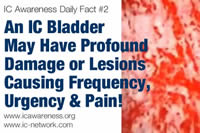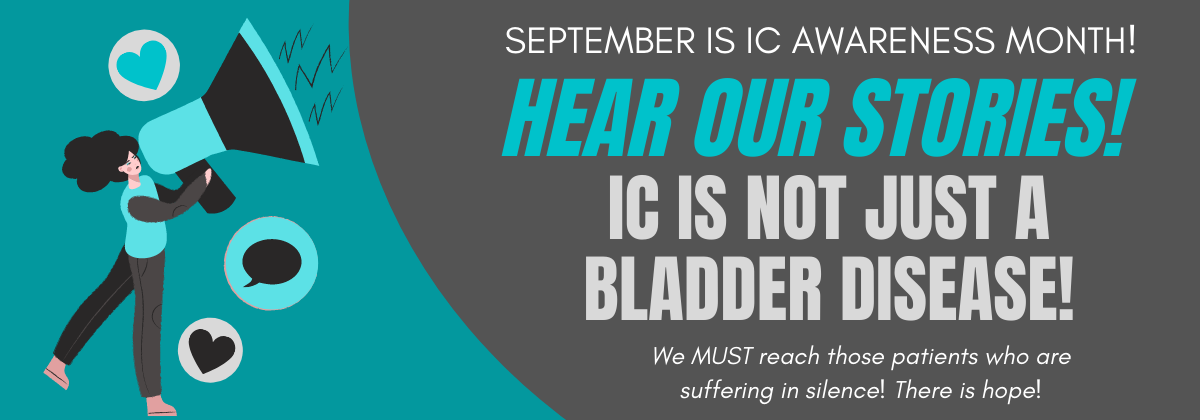IC Fast Facts For Media Professionals
What is IC?
Interstitial cystitis / bladder pain syndrome (IC/BPS) is a chronic pelvic pain condition with an unknown etiology. Patients typically experience “an unpleasant sensation (pain, pressure, discomfort) perceived to be related to the urinary bladder” that lasts longer than six weeks in the absence of infection or other identifiable causes. It is classified with chronic prostatitis as a “urologic chronic pelvic pain syndrome.” Dr. Christopher Payne proposed five potential subgroups:
 Hunner’s Lesions – Areas of deep, profound inflammation in the bladder wall. It affects about 5% of patients and is considered the most severe form. Patients are extremely diet sensitive with pain as the bladder fills with urine. Specific treatment of the lesion is necessary including: fulguration, laser therapy, triamcinolone injection.
Hunner’s Lesions – Areas of deep, profound inflammation in the bladder wall. It affects about 5% of patients and is considered the most severe form. Patients are extremely diet sensitive with pain as the bladder fills with urine. Specific treatment of the lesion is necessary including: fulguration, laser therapy, triamcinolone injection.- Bladder Wall Sensitivity – These patients have pain as the bladder fills with urine that is relieved with urination, along with urinary frequency, urgency and nocturia. They are usually diet sensitive. This can be determined through the use of an anesthetic challenge.
- Pelvic Floor Dysfunction – These patients have tight pelvic floor muscles and/or trigger points that are triggering urinary frequency, urgency, pressure, pelvic pain, discomfort during and after intercourse, constipation, straining and referred pain to the lower back, vagina, rectum and perineum. Treatment begins with pelvic floor physical therapy. These patients are generally labelled as bladder pain syndrome
- Pudendal Neuralgia – These patients have genital and pelvic pain, the result of pelvic floor muscles squeezing the pudendal and other nerves. This is also treated with pelvic floor physical therapy and, if necessary, nerve therapies.
- Functional Somatic Syndrome – These patients have bladder discomfort and symptoms along with other co-existing pain syndromes such as IBS, vulvodynia, fibromyalgia. Generally considered a neurosensitivity disorder, treatment is focused on calming the nervous system. These patients can also be diet sensitive.
Epidemiology
In 2009, the RAND Interstitial Cystitis Epidemiology (RICE) study provided astonishing new data on the prevalence of IC in the USA. This NIH funded study estimated that 3.4 to 7.8 million women in the USA have symptoms of IC. Approximately 1 to 4 million men struggle with symptoms. IC can occur in children, teens, young adults and the elderly.
Diagnosis
It’s not unusual for patients to have seen five or more physicians as they seek medical treatment. A diagnosis of IC/BPS is based on clinical symptoms, including the presence of pain (usually occurring as the bladder fills with urine), frequency and/or urgency. The diagnosis of IC can be made confusing because of the wide variety of names that are often used to describe the symptoms. It’s not unusual for patients to have been misdiagnosed with cystitis, bacterial cystitis, overactive bladder, urethral syndrome, trigonitis, urethritis or a “sensitive” bladder before they receive a correct diagnosis. Men are often mislabelled as prostatitis patients.
Names
This syndrome is called by a variety of names:
- Research – Urologic Chronic Pelvic Pain Syndrome (UPPS)
- Europe – Interstitial cystitis is the diagnosis for patients with Hunner’s lesions. Patients without visible lesions are diagnosed with bladder pain syndrome.
- USA – Patients are collectively labelled IC/BPS though there is growing interest in adopting the European perspective.
- Japan – hypersensitive bladder syndrome (HBS) – primarily in Japan
Treatments
In 2011, the American Urological Association released guidelines for the diagnosis and treatment of IC, including a six step treatment protocol. Patients generally begin with the least invasive therapies and, if needed, progress through the various steps to more invasive therapy. There is a general trend, though, to create a treatment plan based upon the subgroups (aka phenotypes) the patient presents in.
- Step 1 – adequate water intake, diet modification, heat or cold packs, OTC supplements, meditation and guided imagery, pelvic floor relaxation, bladder training, the treatment of other related conditions and the reduction of stress.
- Step 2 – Physical therapy for pelvic floor dysfunction, pain management, various oral medications (Amitryptiline, cimetidine, hydroxyzine, pentosan polysulfate), bladder instillations (lidocaine, heparin, dmso).
- Step 3 – low pressure, short duration hydrodistention, hunner’s ulcer treatment with fulguration, electrocautery, triamcinolone
- Step 4 – neuromodulation, botulinum toxin A
- Step 5 – cyclosporine A
- Step 6 – surgical interventions
Diet
Diet modification is usually the first suggestion offered by physicians and is critical for patients struggling with bladder irritation and inflammation. Foods high in caffeine, acid and alcohol irritate the wounds in the bladder triggering IC flares, pain and discomfort. The foods most patients must avoid include decaf and regular coffees, black teas, green teas, sodas, all cranberry products, most fruit juices, energy drinks, tomato based foods, chocolate and some vitamins (Vitamin C and B6). On the otherhand, some foods can be soothing to an irritated bladder. A comprehensive diet list can be found at: https://www.ic-network.com/diet/
